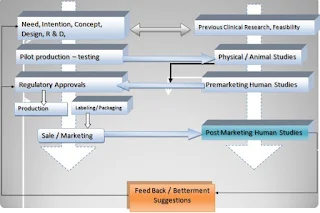The Clinical Trials of medical device's are complex in comparison to drug. So, one has to design the study to overcome the constrains in medical device clinical trials, especially pertaining to comparability and establishment of universal outcomes. There is no perfect control in a medical devices study. Moreover, as there is no “Absolute safety and efficacy” available from experimentation in healthy human subjects, the outcomes of studies remain majorly study specific. Applicability of the trial outcomes to real world is grossly limited.
One of the major problems in Medical Device clinical trials as discussed is lack of a perfect control. Even if some control is selected, the control may have different indications. For example, Stent implant angioplasty and coronary artery bypass graft are the common comparable entities. Both of these treatments and thereby the device “Stent” is studied against a control of CABG. If seen in further details, the coronary artery bypass graft is indicated for some different subset of coronary artery stenosis than angioplasty by stent. Hence even after several trials including ambitious large trials such as Freedom and Subgroup trials such as MAIN-COMPARE, the dispute of which one would be a better treatment was still on. Not this alone, but several other conditions where medical device needs to be compared with a control, which is usually not a perfect control, the outcome is usually disputed. Higher the data available, higher is the confusion. What could be a suggested solution?
Among these, SYNTAX was a trial, which was able to establish some results and lay down definitive guidelines to an extent though. What differs in SYNTAX from other studies was design of the trial. The trial was designed based upon minute details of the therapeutic variations. For comparability, they established a score and made it a compound trial. In only a few other cases, such as LEADERS trial, due to an innovative study design, the outcomes of the trials are closely matching to the real-world observations, unlike many other studies such as from SPIRIT group, Endeavor group, where the outcomes fail to match the day to day clinical outcomes. This makes the point that innovative study designs can overcome some major constrains in Medical Device Clinical trials and can yield reliable and more accurate clinical data which can be used as a standard reference in day to day clinical practice.
What can be different designs of studies? There can be several design options. The first is variation of the hypothesis. In many Medical Device Clinical Trials, the study hypothesis is developed in a way that specific outcomes are tested. For example, in many studies, the hypothesis is designed to register an “Event Free Survival” or “proportion of population free from events in a defined period”. Though these both study questions sound good, practically, the comparison of a medical device on these outcomes is too vague to prove anything in favor of any of the arms. Instead, if the same evaluation is defined in a converse, such as “frequency of adverse events reported in a particular period” or “time taken to relive or produce desired or undesired effect” would be more specific and in a smaller group of population, a better study outcomes can be obtained.
The second important postulate of an innovative study design is inclusion of subsets. In many conditions it is seen that the study design exclude many subsets of the populations, which make the results differ from “real world” scenario. Instead, the predetermined subsets inclusion can give a study a wider acceptance and better power. In fact, based upon this one postulate, the study can be an union matrix study, a multi-arm study, overlapping matrix study etc. These designs are uncommon to use but an intelligent statistician will take efforts to make these ambitious designs. These types of designs may have several expressions such as compartmental design (Tight Subset matrix), blocks design (Loose Subsets Matrix) , clusters design(Loose subsets with stratified or multiple overlapping) ; and the study cohort can be stratified to establish relative betterment.When a device has no perfect control, but if it is considered to be remedial in a particular condition, way of designing the study is multiple controls. This design of study enables the researcher to establish practical comparison of the device with several aspects of treatment such as untreated subjects, Subjects treated with one or more other modes, Subjects treated with device alone, subjects treated with device and subjects treated with combination of therapies. This type of study can be best suited to derive outcomes for new types of devices. The other type of designs can be compound design of multi-arm and single arm trials. This design is best suitable when there is an established treatment for some particular condition. The device which is either new or newly indicated for this condition is to be compared with established treatment. In This scenario, there can be great variance of indication of the device and the established treatment within the same condition. This complexity can be addressed by a compound design of the study, making the arms comparable more correctly.
Use of Standard or Specifically developed scores can be one of the important tools in design for Medical Device Clinical Trials. The Standard Scores Such as Comorbidity Index, Medina Score for Cardiology bifurcation lesion or Study specific scores such as SYNTAX Scores can be highly useful in designing a study and meet specific comparability needs.
Dr. Ashish Indani
Clinical Operations Head
Clinical Operations Head
GENELIFE CLINICAL RESEARCH
33,34,37 Ground Floor, Cinewonder Mall, Ghodbandar Road, Thane West-400607. INDIA
Telephone: Fax: +91 22 25841316
Email: info@genelifecr.com Website: http://www.genelifecr.com/, Blog:http://genelifecr.blogspot.com/
Telephone: Fax: +91 22 25841316
Email: info@genelifecr.com Website: http://www.genelifecr.com/, Blog:http://genelifecr.blogspot.com/











